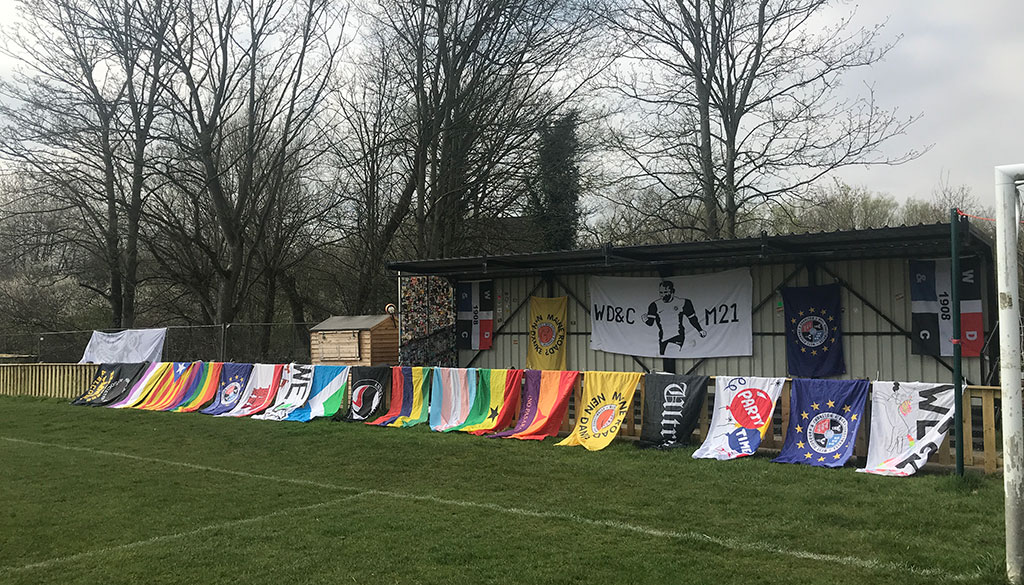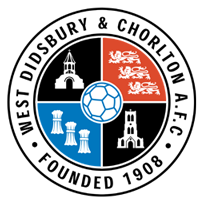
Emblematically Speaking - West Didsbury & Chorlton
Tue 24th April 2018 | West Didsbury & Chorlton | By Stewart Taylor
Our emblem this week features, as its main element, a quartered roundel.
Quartered designs are quite often seen in heraldic constructions, more usually in the form of a shield, and are very versatile. There are a few “rules” when depicting devices within such a design.
Typically, we would see a device representing the location at the top left. At the top right something to represent the heritage.
Bottom left is often a depiction of a local waterway – most typically a river.
Bottom right features a device which might reflect upon a local skill (or skilled trade).
Having said that, the overall design gives pretty much a free hand to the designer. Such is in evidence here, but we can first consider the remainder of the emblem before looking at some of the detail.
The name of the organisation and the year of foundation are clearly seen around the edge of the roundel, with the black and white colouration providing a good contrast with the central features and also representing the playing colours of the club.
That the organisation is a football club is shown by the representation of a football in the centre accompanied by the initials “AFC”.
If we now move to the four devices as depicted we see what we might happily call “a couple of old friends”. The three wheatsheaves represent Cheshire and the three lions, in the passant guardant pose, relate to Lancashire.
The selection of these two charges is entirely appropriate given that West Didsbury AFC became members of the Lancashire and Cheshire Football League on the resumption of organised football after the First World War.
Prior to being known as West Didsbury AFC, the club operated under the name of Christ Church AFC, having been founded by a Sunday School Superintendent of the church in 1908.
The church was, and still is, in West Didsbury and is relevant to our story in that it is depicted as the device in the bottom right quarter of the emblem. The main feature of this mid-Victorian church is the stone tower which is passed by many thousands of motorists every day as they make their commuter runs into and out of Central Manchester.
In the mid 1980s the club were obliged to find a new ground as their ground at the time was earmarked for commercial development. After some time, during which the club led a nomadic existence, the current site at Brookburn Road was acquired.
As many will know, Brookburn Road is in Chorlton, close to Chorlton Green – a conservation area based on the footprint of the old village of Chorlton. This prompted another name change to the one held today reflecting that the club now represented not only West Didsbury but also Chorlton. This is reflected in the final charge on the club emblem which is a representation of Chorlton Green Lych Gate.
Lych gates are essentially roofed gateways into church yards. Their origin is said to be for sheltering a coffin prior to the arrival of the clergyman who was appointed to take the necessary service.
Lych gates go back to the Middle Ages so the one in Chorlton is relatively recent having been constructed in 1888. The lych gate was the entrance to the former St Clement’s churchyard and is now a listed building.
It is unusual in featuring an octagonal, half timbered bell tower and that can be readily seen on the depiction on the club emblem.
In summary, we see an emblem which, through a relatively simple design, tells us not only that we are looking at a football club but also, subject to a little bit of research, tells us a significant amount about the origins and development of the club. Objective achieved.
With thanks to Monica Creer, Rob Madden and Rob McKay of West Didsbury and Chorlton AFC for their help in putting together this article.
 Emblematically Speaking - West Didsbury & Chorlton
Emblematically Speaking - West Didsbury & Chorlton
Tue 24th April 2018 | West Didsbury & Chorlton
By Stewart Taylor

Our emblem this week features, as its main element, a quartered roundel.
Quartered designs are quite often seen in heraldic constructions, more usually in the form of a shield, and are very versatile. There are a few “rules” when depicting devices within such a design.
Typically, we would see a device representing the location at the top left. At the top right something to represent the heritage.
Bottom left is often a depiction of a local waterway – most typically a river.
Bottom right features a device which might reflect upon a local skill (or skilled trade).
Having said that, the overall design gives pretty much a free hand to the designer. Such is in evidence here, but we can first consider the remainder of the emblem before looking at some of the detail.
The name of the organisation and the year of foundation are clearly seen around the edge of the roundel, with the black and white colouration providing a good contrast with the central features and also representing the playing colours of the club.
That the organisation is a football club is shown by the representation of a football in the centre accompanied by the initials “AFC”.
If we now move to the four devices as depicted we see what we might happily call “a couple of old friends”. The three wheatsheaves represent Cheshire and the three lions, in the passant guardant pose, relate to Lancashire.
The selection of these two charges is entirely appropriate given that West Didsbury AFC became members of the Lancashire and Cheshire Football League on the resumption of organised football after the First World War.
Prior to being known as West Didsbury AFC, the club operated under the name of Christ Church AFC, having been founded by a Sunday School Superintendent of the church in 1908.
The church was, and still is, in West Didsbury and is relevant to our story in that it is depicted as the device in the bottom right quarter of the emblem. The main feature of this mid-Victorian church is the stone tower which is passed by many thousands of motorists every day as they make their commuter runs into and out of Central Manchester.
In the mid 1980s the club were obliged to find a new ground as their ground at the time was earmarked for commercial development. After some time, during which the club led a nomadic existence, the current site at Brookburn Road was acquired.
As many will know, Brookburn Road is in Chorlton, close to Chorlton Green – a conservation area based on the footprint of the old village of Chorlton. This prompted another name change to the one held today reflecting that the club now represented not only West Didsbury but also Chorlton. This is reflected in the final charge on the club emblem which is a representation of Chorlton Green Lych Gate.
Lych gates are essentially roofed gateways into church yards. Their origin is said to be for sheltering a coffin prior to the arrival of the clergyman who was appointed to take the necessary service.
Lych gates go back to the Middle Ages so the one in Chorlton is relatively recent having been constructed in 1888. The lych gate was the entrance to the former St Clement’s churchyard and is now a listed building.
It is unusual in featuring an octagonal, half timbered bell tower and that can be readily seen on the depiction on the club emblem.
In summary, we see an emblem which, through a relatively simple design, tells us not only that we are looking at a football club but also, subject to a little bit of research, tells us a significant amount about the origins and development of the club. Objective achieved.
With thanks to Monica Creer, Rob Madden and Rob McKay of West Didsbury and Chorlton AFC for their help in putting together this article.


